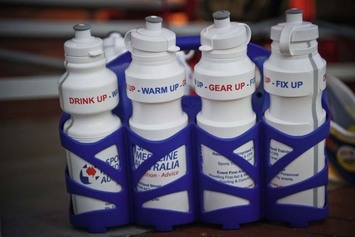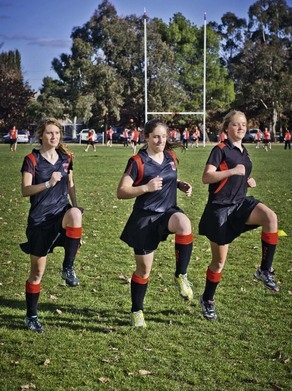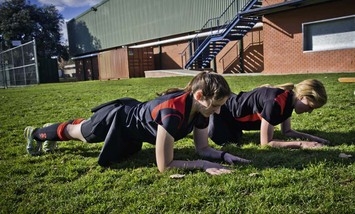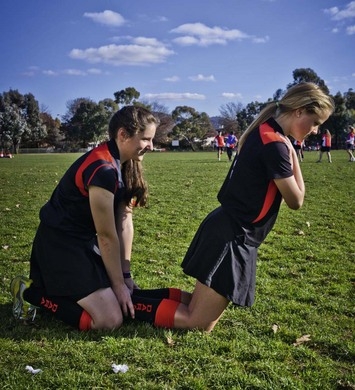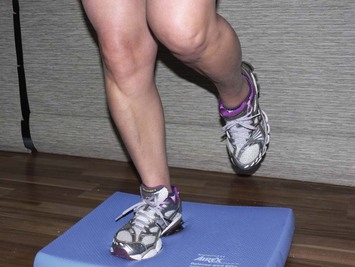Chapter Three Preventing sports injuries
1. Explain the role of a warm-up.
2. Explain the preferred timing and duration of a warm-up.
3. Demonstrate a range of warm-up exercises appropriate for a variety of sports.
4. Explain the role of a cool-down.
5. Explain the preferred timing and duration of a cool-down.
6. Demonstrate a range of cool-down activities appropriate for a variety of sports.
7. Recognise precautions for warm-ups, cool-downs and stretching activities.
8. Demonstrate safe stretching activities.
9. Identify a range of sporting protective equipment.
10. Demonstrate the use of various sporting protective equipment.
General injury prevention principles
Sports Medicine Australia (SMA) advises adopting the following general injury prevention principles:
1. Ensure playing facilities and equipment are well maintained and risk free.
2. Ensure athletes always warm up before training and competition.
3. Ensure athletes achieve as high a level of fitness as possible, including strength, coordination, flexibility and endurance, as well as speed, power and agility appropriate to the sport.
4. Develop athlete skills and techniques appropriate to the chosen sport.
5. Ensure athletes wear appropriate protective equipment.
6. Ensure athletes obey the rules of the sport and respect the safety of team mates and opponents.
7. Encourage balanced competition.
8. Maximise recovery with appropriate rest, nutrition, cool-downs etc, before athletes resume training or playing again.
9. Ensure full recovery from injuries before allowing an athlete to return to sport.
Sports injury surveillance
Sports injury surveillance is the collection of information related to sports injuries. As mentioned in Chapter 1, sports trainers can improve sports injury prevention programs by collecting information about how, when and where injuries occurred. This information can be used to identify patterns or groups of injuries that may have a common cause that can, in turn, be remedied. Injury surveillance starts with the collection of information on a suitable injury report form. This can be either a paper based system or an online system such as Sports Injury Tracker (see www.sportsinjurytracker.com.au).
Medical emergency planning
The Sports Medicine Australia SmartPlay program has developed a planning guide called ‘Medical emergency planning: a practical guide for clubs’ that is available on the SmartPlay website (www.smartplay.com.au). It has a checklist and action plan template that can be used to develop a medical emergency plan.
Extrinsic and intrinsic risk factors for injury
The sporting environment
The weather is another environmental risk factor for sports injury or illness. Excessively hot or cold weather can negatively affect a player’s coordination, which can lead to an increased risk of injury as well as to medical conditions such as hyperthermia or hypothermia (discussed further in Chapter 7). To ensure players’ health and wellbeing is properly protected, another important role for sports trainers is checking that they are properly hydrated and have suitable clothing for the prevailing weather conditions.
Warm-up and injury prevention programs
Warm-up
 increase blood flow to the exercising muscles
increase blood flow to the exercising muscles
 improve muscle contractions and, therefore, force production
improve muscle contractions and, therefore, force production
 reduce muscle tightness to increase flexibility
reduce muscle tightness to increase flexibility
 decrease stiffness of joints and connective tissue such as tendons
decrease stiffness of joints and connective tissue such as tendons
 increase the sensitivity and conduction speed of nerve endings and nerves, which can then improve coordination and reaction time
increase the sensitivity and conduction speed of nerve endings and nerves, which can then improve coordination and reaction time
 prepare the heart and lungs to improve the delivery of oxygen to the body
prepare the heart and lungs to improve the delivery of oxygen to the body
These factors all lead to a decreased chance of injury as well as improved sporting performance.
Planning a warm-up – general principles and other considerations
 Specificity of the exercise – the warm-up activity should include the specific muscles and movements to be used in the subsequent activity.
Specificity of the exercise – the warm-up activity should include the specific muscles and movements to be used in the subsequent activity.
 Participant’s energy levels – it is important to conserve the athlete’s energy for the event to follow.
Participant’s energy levels – it is important to conserve the athlete’s energy for the event to follow.
 Intensity of the exercise – the warm-up should be sufficiently intense to gently increase body temperature. A good guide is that participants should be able to talk with their exercise partners for the duration of the session.
Intensity of the exercise – the warm-up should be sufficiently intense to gently increase body temperature. A good guide is that participants should be able to talk with their exercise partners for the duration of the session.
 Environmental conditions – in cool or cold conditions, the duration of the warm-up will usually need to be longer whereas, in warm or hot conditions, a long or intense warm-up could decrease performance by exhausting the players.
Environmental conditions – in cool or cold conditions, the duration of the warm-up will usually need to be longer whereas, in warm or hot conditions, a long or intense warm-up could decrease performance by exhausting the players.
 Duration of the exercise – the duration of the warm-up will take into consideration the time available and how long it is before the event starts, as well as the environmental and energy level factors mentioned above.
Duration of the exercise – the duration of the warm-up will take into consideration the time available and how long it is before the event starts, as well as the environmental and energy level factors mentioned above.
Components of the warm-up
1. Running drills or other low intensity activities that gradually increase circulation to increase muscle and body temperature. Especially for sports that involve running, these drills can gradually progress from walking or light jogging to include more complex and higher demand movements such as running with knee lifts, shuttle runs, carioca running and many others, preferably those specific to the nature of the sport. More advanced and complex running drills can increase running speed and improve technique as well as increase muscle flexibility and circulation (see Figure 3.2). Additional suitable warm-up activities include swimming, rowing, cycling or other activities that are specific to the actual sport.
2. Strengthening exercises for the major muscle groups used in the particular sport. Properly constructed exercise programs for sports injury prevention and performance take into consideration the way muscles work together in producing sporting movements. The goal is to improve controlled muscle power throughout the full range of movement and to develop muscle balance rather than just developing raw power or the size of individual muscles (see Figures 3.3 and 3.4).
3. Balance and body control exercises. These are designed to improve balance and coordination and to correct the alignment of the body segments during sporting movements, which in turn improves the athlete’s ability to avoid situations where an injury is likely to occur. For example, research has shown a significant reduction in the number of lower joint injuries such as ankle sprains in athletes who have undertaken programs with exercises designed to improve their balance. These exercises often incorporate an unstable surface, such as a wobble board or balance mat, but can also be done effectively on any playing surface (see Figure 3.5). Ensuring that correct lower limb alignment is properly maintained during movements is an important component of body control exercises (see Figure 3.6). Balance and body control exercises can also incorporate sports-related tasks and can be performed in pairs or larger groups (see Figure 3.7).
Stay updated, free articles. Join our Telegram channel

Full access? Get Clinical Tree



